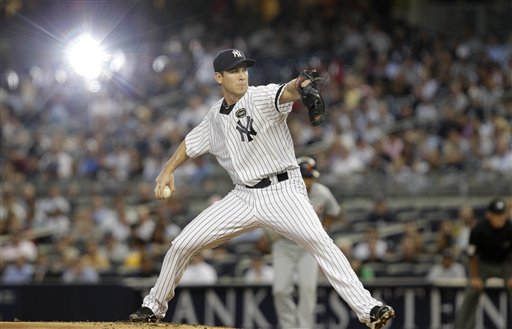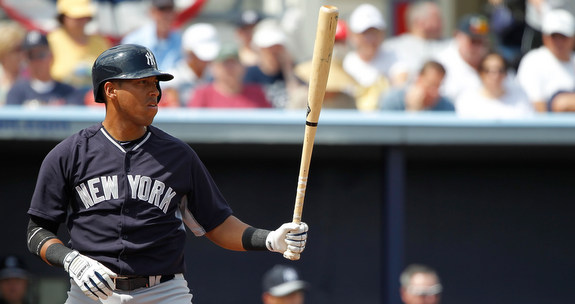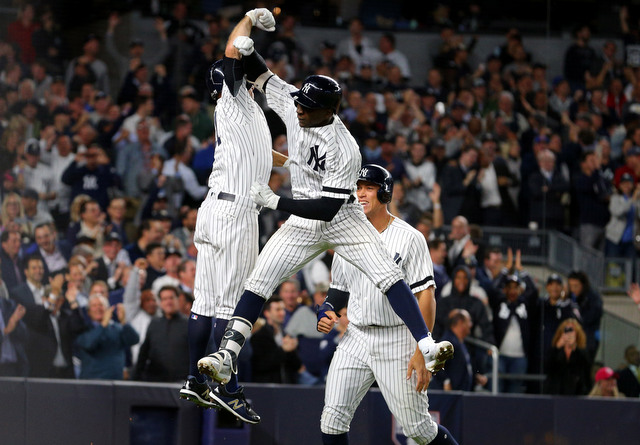
As we prepare to close RAB’s internet doors next Monday, we’ve spent some time recently looking back at the last 12+ years of Yankees baseball. We looked at my favorite games, prospect rankings, and some random players as well. We’ve seen a lot of cool stuff these last dozen years.
Like all sports, there are short-term and long-term events in baseball. Someone has a great game or a hot streak and it’s a one or two or five-day story. There are also the grand overarching themes that take years to develop and play out. Those are the stories that define a franchise. Those are the stories we’re going to look at today.
I think we can split the 12 years of the RAB era into three distinct periods, each of them important in their own way, and each of them featuring countless smaller stories. Here, in my humble opinion, are the three most important big picture stories in recent Yankees history.
The 2008-09 Offseason
To fully understand the 2008-09 offseason, you have to go back to the 2007-08 offseason. The 2007 Yankees won 94 games and went to the postseason, though they were woefully short on pitching, and Joe Torre was shown the door following the season. The Yankees brought in Joe Girardi to manage and had a chance to add a significant piece to the rotation: Johan Santana.
Santana, then 29, was an impending free agent coming off four straight Cy Young caliber seasons. The Twins were not going to be able to keep him and his availability was no secret. The Yankees, Red Sox, and Mets were among the most serious suitors. The Yankees reportedly offered Phil Hughes, Melky Cabrera, and Jeff Marquez for Santana, and stood their ground. They set a deadline for trade talks and wouldn’t raise their offer, so Johan wound up in Flushing.
“The deadline is the deadline. I extended it a few hours more, and that was it. So it’s done,” Hank (not Hal) Steinbrenner told Tyler Kepner after Santana was traded to the Mets. “I’m very pleased. We got Andy Pettitte back, and everything I wanted to accomplish at the beginning of the off-season has happened. We got Pettitte, (Alex) Rodriguez, (Jorge) Posada, and (Mariano) Rivera back. We’ve got our young pitchers. I’m very glad we didn’t have to lose Hughes and Cabrera. Everything is copacetic.”
Santana was brilliant in 2008 while the Yankees struggled, partly do to injuries but mostly because they didn’t have enough pitching and simply weren’t that good. The Yankees missed the postseason in 2008 for the first time since 1993. After the season, the Yankees enacted the plan that led to them passing on Santana a year prior. They wanted to keep their young players and sign CC Sabathia, who was then only 27. (Easy to forgot how young Sabathia was when the Yankees signed him, isn’t it?)
It was a high-risk plan, to be sure. There were no guarantees Sabathia would sign with the Yankees — there was lots of chatter about Sabathia wanting to play close to home in California and staying in the National League because he wanted to hit — or even become a free agent, plus the Brewers ran him into the ground late in 2008. We had a little “freak out about Sabathia’s workload” period here at RAB.
Ultimately, the Yankees wooed Sabathia with what was then the largest pitching contract in baseball history, a seven-year deal worth $161M. The contract included an opt-out clause following the third season that would allow Sabathia to escape should he not enjoy New York. Brian Cashman later admitted they signed Sabathia not only because he was a great pitcher, but because they felt they needed his presence in the clubhouse.
Sabathia was the key to the 2008-09 offseason plan. He was not the only part of the plan, however. The Yankees also signed A.J. Burnett to a five-year contract and straight up stole Nick Swisher from the White Sox, giving them added rotation depth and a middle of the order bat, respectively. Then, on December 23rd, the Yankees swooped in to sign Mark Teixeira, who appeared set to join the Red Sox.
“Without a doubt, this was a deviation from our plan. We felt he was a rare, exceptional opportunity,” Cashman told the Associated Press after the Teixeira deal. The Yankees added to the rotation in a big way with Sabathia and Burnett, and Swisher was penciled in as the starting first baseman with Xavier Nady in right. Cashman convinced ownership to splurge on Teixeira, and once the Steinbrenners signed off, a deal came together quickly.
The Yankees got to have their cake and eat it too during the 2008-09 offseason. The Santana/Sabathia plan worked, they added Burnett and Swisher, and then capped it all off with Teixeira. The Yankees did all that while retaining their top young players as well. Hughes was the team’s ace setup man in 2009, Melky was their regular center fielder, and Marquez was used to acquire Swisher.
The 2008-09 offseason paved the way for the 2009 World Series championship. Teixeira was the MVP runner-up en route to 103 regular season wins, Sabathia was an ace from April through November, Burnett was an above-average innings guy, and Swisher was maybe the best “eighth best player on the team” in baseball history. Those moves contributed greatly to the 2009 World Series as well as ALCS trips in 2010 and 2012.
It’s been ten years now and it can be easy to forget just how much doubt was involved with that 2008-09 offseason. Was passing on Santana the right move? Would Sabathia sign with the Yankees? Would Burnett stay healthy? Would Swisher rebound from a rough 2008? Would the Yankees splurge for Teixeira? Were the young players worth keeping? Across the board, the answers were a resounding yes. It was a franchise-altering offseason.
The 2016 Trade Deadline

You have to give the Yankees credit. Even as baseball’s post-competitive era began to take shape in recent years, they refused to throw in the towel and tank. Even when things fell apart in 2013, the Yankees tried like crazy to stay in the race, hence the Alfonso Soriano trade. They added Chase Headley, Martin Prado, and Brandon McCarthy weeks before the July 31st trade deadline in 2014 because they couldn’t wait any longer for help.
The 2015 Yankees faded badly in the second half — they were six games up on trade deadline day and finished the season six games back — and their sluggish play carried over into the first half of 2016. On the morning of July 31st, the Yankees were a fourth place team at 52-51 with a -31 run differential. They weren’t truly awful, but they weren’t good, and they were old. Roster turnover was required.
It had been nearly three decades since the Yankees last sold at the trade deadline. You had to go back to 1989, when they traded Rickey Henderson, John Candelaria, and Ken Phelps within the span of a few weeks. The 2016 Yankees had several valuable trade chips on expiring contracts and Cashman later admitted he wanted to sell at the deadline all along. It was a matter of convincing ownership to sign off.
“I think it influenced the people above me more. The inconsistency of our club reared its ugly head. A true playoff contender wouldn’t have done that,” Cashman told Andrew Marchand and Brendan Kuty after the Yankees were swept by a crummy Rays team in late July. “… We’ve been contending for a long time, and we’re damn proud of that. That’s a hell of a run. That run of contention and being legitimately considered a team that could win a championship on a year in, year out basis has gone on for a long time. There’s, from my perspective, no shame in anything we’ve tried to address (at the deadline).”
The Yankees had two valuable rentals in Aroldis Chapman and Carlos Beltran, and a slightly less valuable (but still useful) rental in post-Tommy John surgery Ivan Nova. They also had a trump card: Andrew Miller. Miller was signed another two seasons beyond 2016. He was great, he was affordable, he was a long-term add, and the Yankees did not have to trade him.”We wanted a firstborn for Chapman. We needed two twin firstborns for Miller,” Cashman told Marchand.
The Yankees controlled the bullpen market at the 2016 deadline. Cashman had all the leverage. The trade deadline moves:
- July 26th: Traded Aroldis Chapman to the Cubs for Gleyber Torres, Adam Warren, Billy McKinney, and Rashad Crawford.
- July 31st: Traded Andrew Miller to the Indians for Clint Frazier, Justus Sheffield, Ben Heller, and J.P. Feyereisen.
- August 1st: Traded Carlos Beltran to the Rangers for Dillon Tate, Erik Swanson, and Nick Green.
- August 1st: Traded Ivan Nova to the Pirates for two players to be named later (Tito Polo and Stephen Tarpley).
(The trade deadline was August 1st that year because July 31st landed on a Sunday.)
Two things about the 2016 deadline activity. One, it took about a year for baseball and the bullpen market in general to reveal just how well the Yankees did in the Chapman and Miller trades. Those deals were a perfect storm. The Yankees had two elite relievers to peddle and there were two contenders desperately trying to end very long World Series droughts and willing to pay big to get the bullpen help they needed.
The Yankees turned two relievers — excellent relievers, but still relievers, one of whom was due to become a free agent after the season — into eight players, including three top 100 prospects and an above-average big league reliever. Chapman’s Cubs and Miller’s Indians met in the World Series that year and the series went to extra innings in Game Seven. It was a bonkers series. Cashman leveraged his trade chips and Chicago’s and Cleveland’s desperation expertly.
And two, the full impact of the 2016 deadline is just now being realized, three years out. Torres, despite his recent slump, is an absolute stud and already one of the best middle infielders in the game. Frazier is starting to establish himself at the big league level after some injury injuries. Sheffield and Swanson became James Paxton. Tate was part of the Zack Britton trade. McKinney was part of the J.A. Happ trade. Polo was part of the big Todd Frazier/Tommy Kahnle/David Robertson trade. Crawford, Heller, Feyereisen, Green, and Tarpley remain in the organization.
For all intents and purposes, the Yankees turned Miller and three rentals into two long-term lineup keepers (Torres and Frazier) and two years of a high-end starting pitcher (Paxton), plus miscellaneous pieces. Also, while it was not a trade, releasing A-Rod was part of the general “dump veterans and go young” movement in 2016. The trades and A-Rod being released opened playing time for Gary Sanchez, Aaron Judge, Tyler Austin, and Chad Green down the stretch. That’s not nothing.
“We’re winning because of the moves we made,” Cashman told Tyler Kepner in September 2016. “Gary Sanchez wouldn’t have gotten up here if we don’t make the moves that we made. Gary went off and did his stuff. He’s had the biggest impact of them all, but there was no way to get Gary up unless we made trades.”
Keep in mind the Yankees made moves designed to improve the team immediately at the 2016 trade deadline as well. This goes back to the whole “never tearing it down” thing. Warren was part of the Chapman trade and the Yankees added Tyler Clippard in a trade with the Diamondbacks. They wanted to remain competitive. Sure enough, the Yankees had a 52-51 record (-31 run differential) before the trade deadline and a 32-27 record (+9 run differential) thereafter.
From 2013 through the 2016 trade deadline, the Yankees were largely trying to hang around and figure out ways to remain in contention even though it was pretty obvious the roster needed to be turned over. They were surviving rather than thriving. The 2016 deadline marked the changing of times. That’s when the Yankees and ownership admitted change was needed and change was enacted. It was a watershed moment. A long overdue change in the franchise’s direction.
The Youth Movement

Obviously, the 2016 trade deadline contributed to the youth movement that helped the Yankees get to Game Seven of the 2017 ALCS and makes up the bulk of their current roster (when healthy, anyway). The youth movement started a long time ago though. Long before the 2016 trade deadline. As much as those trades helped, guys like Sanchez and Judge and Luis Severino were already in the organization at the time.
Late in 2013 and throughout 2014, Hal Steinbrenner called for what was essentially an audit of the player development system. What’s working? What can be improved? How do we get ahead of the game? Things like that. A massive farm system overhaul followed. Most notably, longtime farm system head Mark Newman was ushered into retirement, with top Cashman lieutenant Gary Denbo taking the reins. Other player development changes included:
- Many new coaches and coordinators hired. There was a lot of turnover in 2015.
- Renovated the minor league complex in Tampa. It is now state of the art.
- Created a dedicated data analysis group for the minor league side.
- Added two additional rookie ball affiliates (Pulaski and a second Gulf Coast League team).
“Yes, we took a good hard look at player development and scouting, and we made changes and added key personnel,” Hal Steinbrenner told Joel Sherman in January 2014. “There will be more changes to come. We think the draft from a year and a half ago and six months ago were both good. But we have to continue to stay on it because we haven’t had players come through that we felt could contribute.”
With the exception of the Cito Culver and Dante Bichette draft picks, which came during the team’s thankfully short-lived “makeup > talent” era, the Yankees were very good at talent acquisition during the RAB era. They brought in high-upside players with athleticism, both through the draft and internationally, but they struggled to help those players turn their natural talent into baseball skills. It was a development problem, not a talent acquisition problem.
It is impossible to know exactly how much of the team’s recently player development success can be attributed to the farm system overhaul from 2013-14. Perhaps players like Sanchez and Severino and Judge are just so talented that they were going to make it no matter how much the Yankees tried to screw up their development. It’s possible. Is it likely? No, I don’t think so, but sure, it’s possible.
I know this much: The Yankees struggled to develop even complementary players for a long time in the 2000s and early 2010s. How desperate where the Yankees for a Domingo German from, say, 2004 to 2014? Very. They were very desperate for a guy like German. Now German probably doesn’t even crack the top five when looking at the most impressive young players on the Yankees’ roster (when healthy).
The Yankees aren’t just getting youngsters to the big leagues either. They’re producing impact players who, well, have an impact right away. Severino in 2015, Sanchez in 2016, Judge in 2017, Torres and Miguel Andujar in 2018. They’ve hit the ground running in the big leagues. Also, the Yankees have developed lots of prospects into trade chips too, especially late rounders like Josh Rogers (11th), Dustin Fowler (18th), and Phil Diehl (27th).
The 2016 trade deadline would not have had the impact it has without the Yankees figuring things out on the player development side. They’re not perfect, no one is when it comes to developing prospects, but they are so much better at it right now than they were the first seven or eight years of the RAB era. It’s not even close. For much of my life, the Core Four Five was the Yankees, and understandably so. That era is over and a new one with a new homegrown core has begun. It didn’t happen overnight, but it happened, and that’s the most important thing.
* * *
On a more micro scale, other notable stories during the RAB era include CC Sabathia’s late career reinvention, Curtis Granderson becoming a 40-homer guy almost literally overnight following a mid-season swing change, Robinson Cano developing into one of the game’s truly elite players, the various milestones (Jeter’s 3,000th hit, A-Rod climbing the home run leaderboard, etc.), and the various farewells (Jeter, Rivera, etc.)
My least favorite stories to cover over years? The Biogenesis scandal and fallout, and the various luxury tax plans. Easy, easy calls for me. I am so over the performance-enhancing drug faux-outrage. What a giant waste of time. The luxury tax talk? Completely sick of it. Sick of writing about the Yankees adhering to the luxury tax threshold and sick of what it’s doing to baseball overall, or at least what it’s become an excuse for owners to do. I will not miss PEDs or luxury tax at all once RAB shuts down. Everything else? That was all pretty cool.







